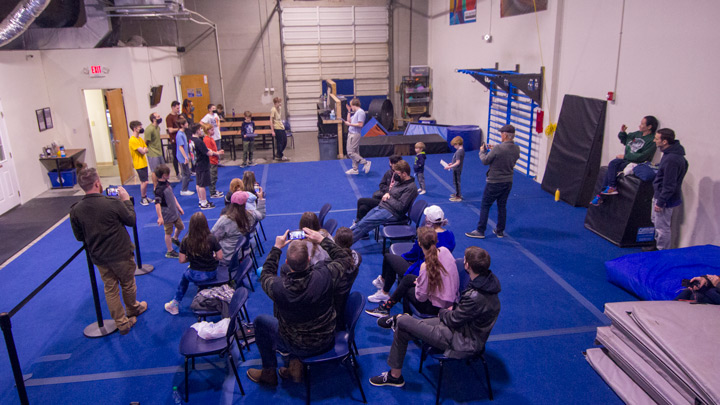March Speed Competition Post-Event Report

March 16th, 2022 | March Speed Parkour Competition Post-event
Competitive speed parkour where time is everything
Competitive speed parkour is where athletes race to have the fastest course times on set routes. Athletes aim to balance maximizing speed while minimizing danger on a route that takes them over, under, and through various gaps, heights, and spaces. It is generally recommended for skilled and experienced practitioners.
The March Speed Parkour Competition started off with a stacked field of twelve competitors across four age brackets. Friends and families joined to cheer on the athletes as they raced throughout the night. This event highlighted three routes of various lengths for the athletes to test their speed. Setting routes is one of the most challenging components of speed competitions. To stay inherent to the nature of parkour, under a competitive spirit, our team wants to ensure we spotlight skills and the sense of challenge that is applied in parkour training. The outcome is using a myriad of “environmental categories’ that was selected and placed on the routes. We use Duncan Germain’s (TK17 Studios) specification of open spaces and gaps; high and low walls; high and low rails; and weird and unusual spaces. The factors give us diverse courses that place the athletes and their skills under the heavy pressures of competing.
The first course was timed in a preliminary testing round of 10-15 seconds by adult judges. After the route was shown, the field had five to seven minutes of practice before individually timed routes. This route featured a variety of open space and various gaps at a low- to mid-height level. There was little ascension featured. We wanted to ensure the beginning round was helping athletes get into the right headspace by eliminating high risk from the start.
The second course was timed in a preliminary testing round of 26-40 seconds by adult judges; athletes had seven to ten minutes of practice. This was intentionally set as a “long-endurance” round with unconventional obstacles from tight spaces, large descents, and foam-pit-cross. Parkour is generally practiced in short bursts of power with practitioners seeking to clear large gaps. Longer routes pull the reigns back on both the power and technical capabilities of what athletes can pull off on a course. We also wanted to place pressure on decision-making skills by forking paths that challenge what skills were effective when and where. There was a fall during a kid’s timed route and we were fortunate that he was able to have a second attempt with strong crowd support.
The last course had preliminary testing times of 24-30 seconds by adult judges and athletes had five to ten minutes of practice. We packed in more risk with checkpoints at height on various equipment including walls and rails. This particular route removed open space elements seen in previous routes and tightened up transitions between one obstacle to another. Lastly, the center-of-gravity mass lines held the largest differences in both ascending and descending from obstacles – this is where strength and skill largely apply!
Our event team had an absolute blast putting on the friendly competition. It is always amazing to see practitioners place their skills under the spotlight and pressures of performing under external influences. Whether that’s a timer or in the eye of judges, competition is a great way to find a sense of challenge and measure of marked improvement. Join us for the next one!

